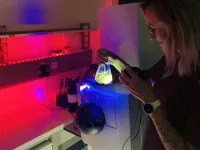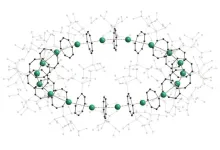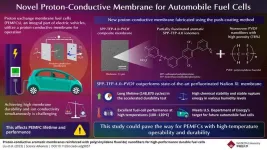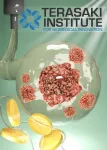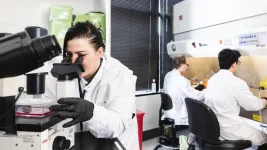(Press-News.org) Light affects living organisms in many different ways: for example, plants orient their growth direction towards the sun, while circadian rhythms in humans are controlled by daylight. These processes always involve photoreceptors, which are proteins that can sense different colours and intensities of light.
10,000-fold increase in enzymatic activity
Now, researchers at Graz University of Technology (TU Graz) have deciphered the function of a highly efficient photoreceptor. Their findings have been published in the journal Science Advances. The research team studied a diguanylate cyclase protein that is found in many bacteria. Its enzymatic function regulates the production of a central messenger substance that controls the way bacteria live. In darkness, the protein is almost completely inactive, but as soon as it is exposed to blue components of daylight, its enzymatic activity increases rapidly. “The protein’s enzymatic activity is about 10,000 times higher when it is exposed to light than it is in the dark," said Andreas Winkler, Head of the Photobiochemistry Working Group at TU Graz’s Institute of Biochemistry. In most photoreceptors, activity increases by a factor of between 5 and 50, resulting in more gradual changes in protein activity. “By contrast, the protein that we characterised reacts very strongly, so it actually works like an on-off switch,” Winkler explained. An efficient protein switch like this could be used in future to enhance and optimise optogenetic tools.
Protein stretches under blue light
The researchers have now unlocked the architecture and function of the protein switch. The protein consists of two functional parts: one is responsible for the perception of blue light, and the other for the actual enzymatic activity, serving as the catalyst for a chemical reaction. If it is exposed to blue light, the protein changes its structure. When it is inactive, the whole protein is in a compact form, but when it comes into contact with light, the protein stretches, connecting the previously separated enzymatic parts. Then, the protein produces specific messenger molecules which signal to the bacterium that environmental conditions are changing. If possible, the bacterium adapts to these new conditions. “An example of this is the formation of aggregates, known as biofilms, which make bacteria more resistant to environmental influences," Andreas Winkler explained.
Potential medical application
“I’m really excited that our research has generated valuable insights into the mechanism of this fascinating protein," commented Uršula Vide, first author of the study and a PhD student at the TU Graz Institute of Biochemistry. “Understanding the mechanism behind this light-activated enzyme switch opens the door to possible applications in a range of different disciplines.” One of these is in optogenetic treatment methods used in medicine. Drugs linked to a light-regulated protein switch could take effect at a precise time and only in a very limited area of the body, which would reduce potential side effects. A light-induced protein switch would also deliver benefits for research into cell biology, as this would enable targeted triggering of specific changes at the molecular level that could then be analysed more effectively. “But we are still a long way away from such practical applications of this particular switch,” Winkler pointed out. However, he believes that his team’s research has produced some important, fundamental insights.
Three-dimensional model
For their experiments, the researchers did not isolate the protein from the original bacteria, but instead produced it in the laboratory with the help of genetic engineering. They used X-ray diffraction to analyse the molecular structure, which formed the basis for a three-dimensional model. Combined with supplementary experiments, this model allowed the researchers to draw inferences about the changes in the protein’s structure upon exposure to blue light, which translated into specific conclusions about the molecular function of the biological switch.
END
On-off switch for enzymes
Researchers at Graz University of Technology have gained new insights into the functioning of a protein found in bacteria, whose enzymatic activity is activated by blue light.
2023-08-03
ELSE PRESS RELEASES FROM THIS DATE:
New-generation geostationary satellite reveals widespread midday depression in dryland photosynthesis during 2020 western US heatwave
2023-08-03
The western U.S., particularly the Southwest, has experienced a notable increase in record-breaking high temperatures over recent decades, with recurring drought and heatwaves. These conditions have resulted in severe consequences for both human and nature systems, including dire water shortages, rampant wildfires, substantial agricultural losses, and increased human mortality. These regions, dominated by water-limited ecosystems, face exacerbated water stress due to more frequent and protracted droughts and heatwaves, which can profoundly impair ecosystem ...
Nanorings: New building blocks for chemistry
2023-08-03
Sandwich complexes were developed about 70 years ago and have a sandwich-like structure. Two flat aromatic organic rings (the “slices of bread”) are filled with a single, central metal atom in between. Like the slices of bread, both rings are arranged in parallel. Adding further layers of ‘bread’ and ‘filling’ produces triple or multiple sandwiches. “These compounds are among the most important complexes used in modern organometallic chemistry,” says Professor Peter ...
Rural environment supports children’s immune systems
2023-08-03
Children raised in rural environments who spend a lot of time outdoors with some exposure to animals grow to have better regulated immune systems than children living in urban environments, a new study has found.
Research led by APC Microbiome Ireland (APC), a world-leading SFI research centre and University College Cork (UCC), has shown that early life immune development is highly dependent on a child’s living environment and lifestyle factors. Researchers say that the immune system needs to learn how not to over-respond ...
Novel proton-conductive membranes for automobile fuel cells
2023-08-03
Fuel cells are compact energy conversion units that utilize clean energy sources like hydrogen and convert them into electricity through a series of oxidation–reduction reactions. Specifically, proton exchange membrane fuel cells (PEMFCs), an integral part of electric vehicles, utilize proton-conductive membranes for operation. Unfortunately, these membranes suffer from a trade-off between high durability and high ion conductivity, affecting the lifetime and performance of PEMFCs.
To overcome this issue, scientists ...
UT extension to help Tennessee farmers navigate labor management
2023-08-03
University of Tennessee Extension and GAP Connections recently received a grant from the Southern Extension Risk Management Education Center to launch a series of workshops across the state to help agricultural producers and agribusinesses navigate the intricacies of labor management.
Tennessee’s labor-intensive farming operations are increasingly in need of agricultural labor options, creating challenges for agricultural employers that have transitioned from readily available family labor to scarce hired labor that ...
More girls started puberty early during the COVID-19 pandemic
2023-08-03
WASHINGTON—The number of girls diagnosed with precocious puberty increased during the COVID-19 pandemic due to potential risk factors such as increased screen time and less physical activity, according to a new study published in the Journal of the Endocrine Society.
The number of girls referred to pediatric endocrinologists for precocious puberty has increased significantly over the last two years, potentially due to the COVID-19 pandemic. Precocious puberty is when children's bodies begin to change into adult bodies too soon. They start to develop physical changes before the age of 8 such as breasts ...
It’s 2023, and coming out is, well, complicated
2023-08-03
In an era of unprecedented LGBTQ2+ visibility coupled with incredible backlash, coming out as a sexual minority can be a deeply ambivalent experience, according to new research.
In a study published in Theory and Society, sociologists Dr. Amin Ghaziani and Andy Holmes conducted in-depth interviews with 52 adult Vancouverites about their experiences coming out over the last five years.
We spoke to Dr. Ghaziani (he/him), professor in the UBC department of sociology and Canada Research Chair in Urban Sexualities, about the findings.
Why were you interested in recent experiences of coming out?
Coming out is about sharing your identity with someone, and it’s an ongoing ...
Enhanced tumor modeling using Laponite bioinks for 3D bioprinting
2023-08-03
(LOS ANGELES) – August 3, 2023 - Scientists from the Terasaki Institute for Biomedical Innovation (TIBI) have developed a nanoengineered bioink with improved bonding and cross-linking capabilities for 3D bioprinting of tumor models. A key component of this bioink is Laponite, highly charged, disk-shaped, crystalline nanoparticles. As explained in their recent paper in Biofabrication, these nanoparticles were shown to enhance the biological signaling that occurs in the tumor microenvironment ...
Sharing on Facebook reveals 2 very different news environments
2023-08-03
COLUMBUS, Ohio – A first-of-its-kind study examined 2.2 million news stories shared on Facebook and found that publishers create two very different news environments.
These distinct ecosystems involve low-credibility publishers – those that publish what is sometimes referred to as fake news – versus high-credibility publishers.
Findings showed that while these two types of publishers often pushed out bursts of coverage at the same time – a common feature of news coverage – they were often about different topics, said Kelly Garrett, senior author of the study and professor of communication at The Ohio State University.
“These ...
The Access to Advanced Health Institute receives $18 million award to develop a temperature stable, single-dose chikungunya RNA vaccine through a phase 1 clinical trial
2023-08-03
The Access to Advanced Health Institute Receives $18 Million Award to Develop a Temperature Stable, Single-Dose Chikungunya RNA Vaccine Through a Phase 1 Clinical Trial
KEY POINTS:
The goal of the award is to develop an effective chikungunya vaccine candidate that can reach endemic areas of the world by using AAHI’s innovative RNA platform technology.
The project will demonstrate that classic large-scale manufacturing challenges of live-attenuated vaccines can be overcome by using standard manufacturing equipment and techniques that are easy to tech transfer and scale.
The award supports a first-in-human clinical trial of a dried (lyophilized) ...
LAST 30 PRESS RELEASES:
Tracing the quick synthesis of an industrially important catalyst
New software sheds light on cancer’s hidden genetic networks
UT Health San Antonio awarded $3 million in CPRIT grants to bolster cancer research and prevention efforts in South Texas
Third symposium spotlights global challenge of new contaminants in China’s fight against pollution
From straw to soil harmony: International team reveals how biochar supercharges carbon-smart farming
Myeloma: How AI is redrawing the map of cancer care
Manhattan E. Charurat, Ph.D., MHS invested as the Homer and Martha Gudelsky Distinguished Professor in Medicine at the University of Maryland School of Medicine
Insilico Medicine’s Pharma.AI Q4 Winter Launch Recap: Revolutionizing drug discovery with cutting-edge AI innovations, accelerating the path to pharmaceutical superintelligence
Nanoplastics have diet-dependent impacts on digestive system health
Brain neuron death occurs throughout life and increases with age, a natural human protein drug may halt neuron death in Alzheimer’s disease
SPIE and CLP announce the recipients of the 2025 Advanced Photonics Young Innovator Award
Lessons from the Caldor Fire’s Christmas Valley ‘Miracle’
Ant societies rose by trading individual protection for collective power
Research reveals how ancient viral DNA shapes early embryonic development
A molecular gatekeeper that controls protein synthesis
New ‘cloaking device’ concept to shield sensitive tech from magnetic fields
Researchers show impact of mountain building and climate change on alpine biodiversity
Study models the transition from Neanderthals to modern humans in Europe
University of Phoenix College of Doctoral Studies releases white paper on AI-driven skilling to reduce burnout and restore worker autonomy
AIs fail at the game of visual “telephone”
The levers for a sustainable food system
Potential changes in US homelessness by ending federal support for housing first programs
Vulnerability of large language models to prompt injection when providing medical advice
Researchers develop new system for high-energy-density, long-life, multi-electron transfer bromine-based flow batteries
Ending federal support for housing first programs could increase U.S. homelessness by 5% in one year, new JAMA study finds
New research uncovers molecular ‘safety switch’ shielding cancers from immune attack
Bacteria resisting viral infection can still sink carbon to ocean floor
Younger biological age may increase depression risk in older women during COVID-19
Bharat Innovates 2026 National Basecamp Showcases India’s Most Promising Deep-Tech Ventures
Here’s what determines whether your income level rises or falls
[Press-News.org] On-off switch for enzymesResearchers at Graz University of Technology have gained new insights into the functioning of a protein found in bacteria, whose enzymatic activity is activated by blue light.
